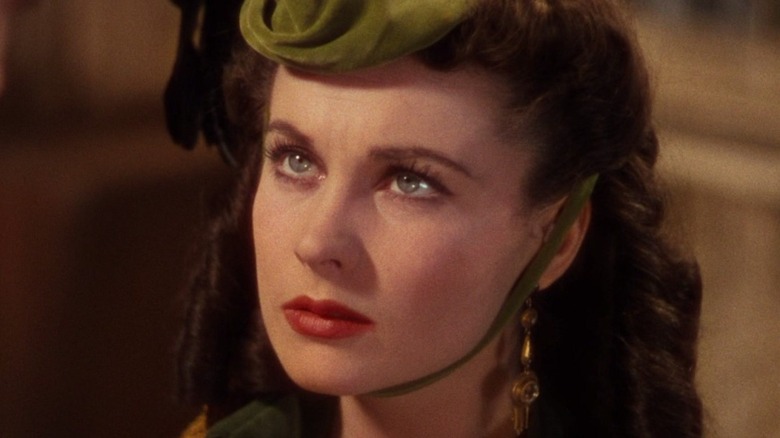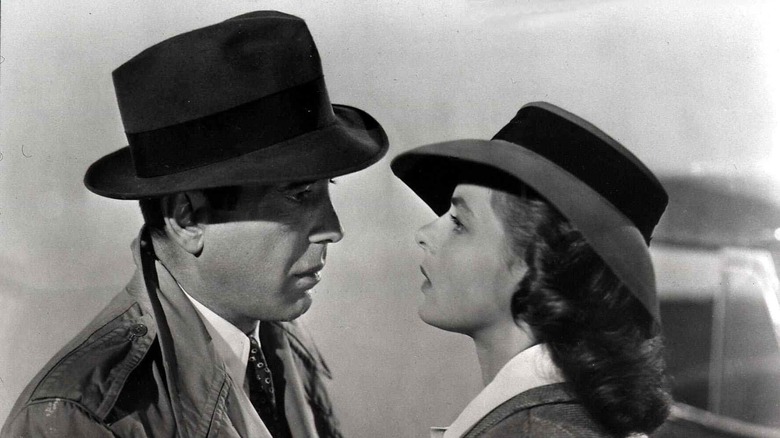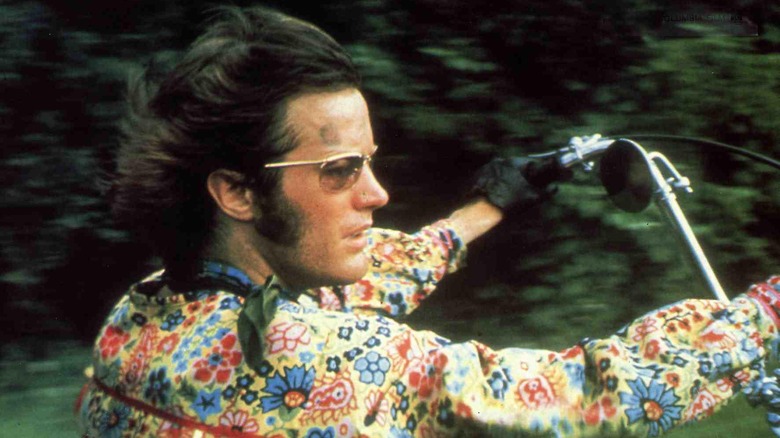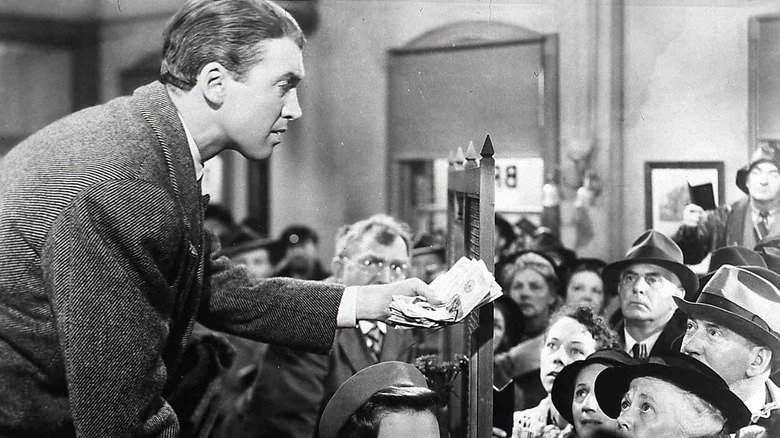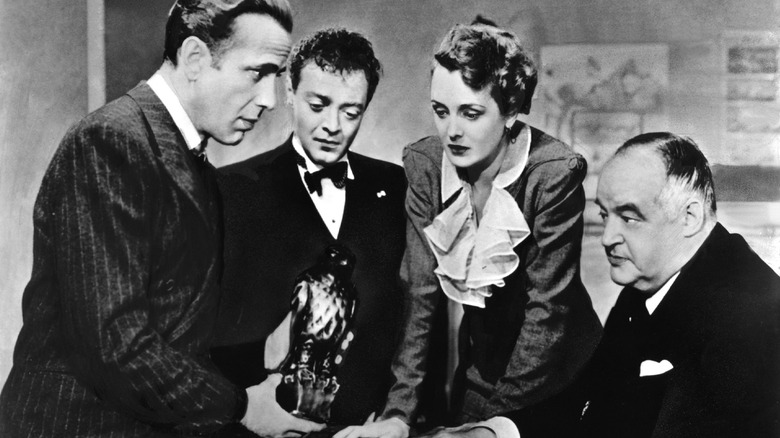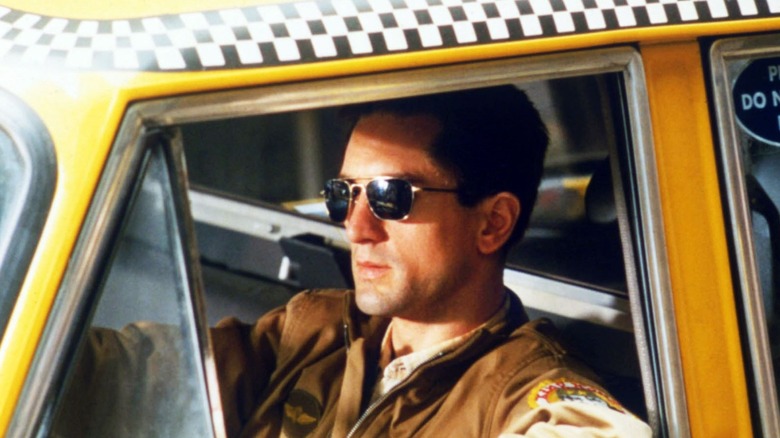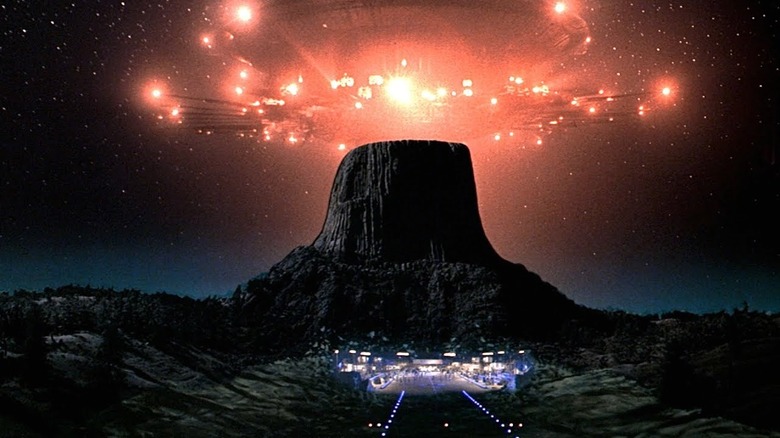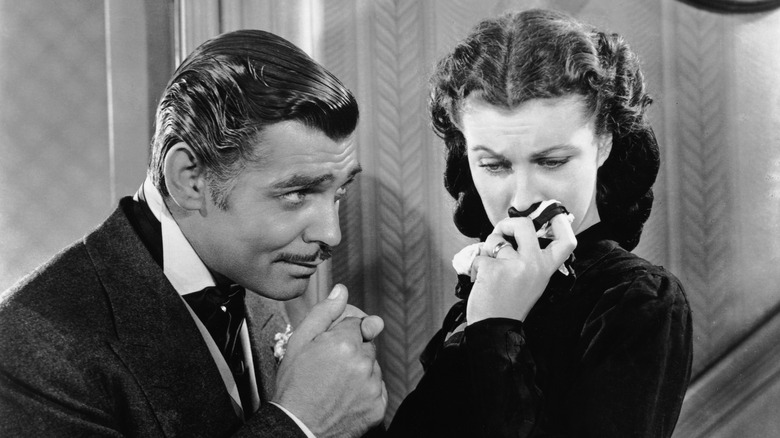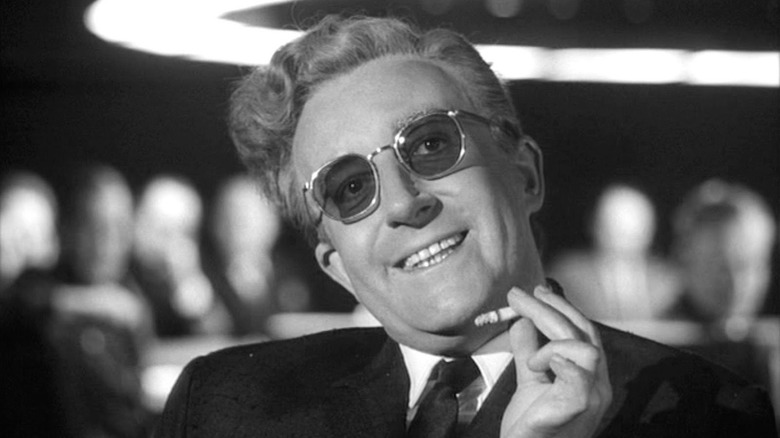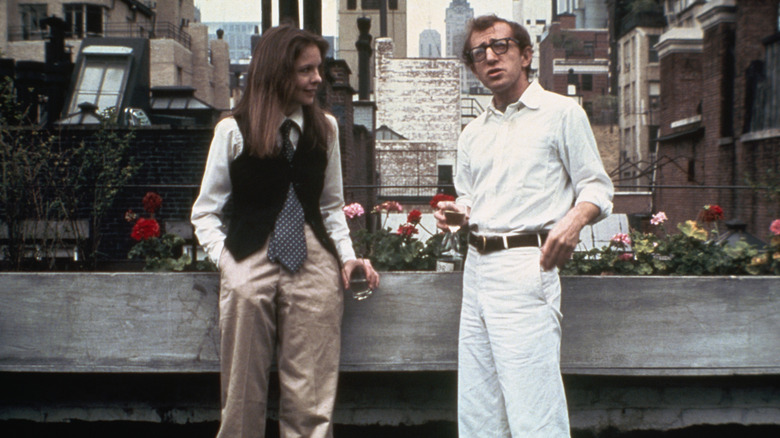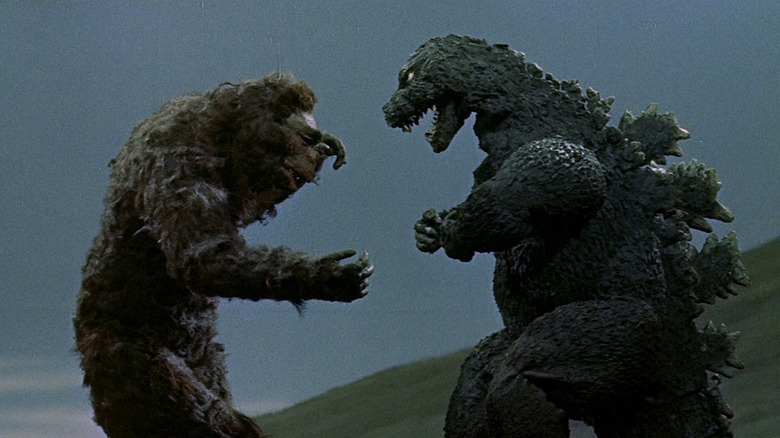The Real Reason These Classic Movies Didn't Get A Sequel
We may receive a commission on purchases made from links.
The modern film landscape is littered with sequels. Throw a rock and you're bound to hit a movie that's some kind of continuation of an older motion picture. While they haven't always been as dominant as they are today, Hollywood has always had a fondness for trying to wring extra money out of a lucrative property. Classic movie characters like Rooster Cogburn or The Wolfman went on to headline multiple features, ditto the quintessential Kaiju, Godzilla.
However, just because there's always been a tendency to create a follow-up to something profitable doesn't mean every classic movie has received a sequel. Many of the greatest features ever made were, at one point in time or another, meant to receive a second film, but fate intervened and left these prospective sequels on the drawing board.
The reasons behind why these sequels went unmade vary greatly from one project to the next. One follow-up may have been doomed simply by the lack of creative participants from the original feature returning, another may have been halted by legal issues, while yet another could have seen its existence thrown away by issues getting a workable script together. Whatever the problems were, these unmade sequels to classic movies prove that, even if there's lots of money to be made, even Hollywood will draw the line at making sequels somewhere.
Casablanca
When you think of "Casablanca," it's easy to have any number of lines, moments, and performances from the film immediately pop into your head. What almost certainly doesn't cross your cranium is the prospect that "Casablanca" could've inspired a sequel. The whole project works so well as a standalone affair that there doesn't seem to be any reason to continue the adventures of this world. However, back in 1944, there were serious attempts to make another "Casablanca" in the form of a prospective feature entitled "Brazzaville."
The title references a location that Captain Renault (Claude Rains) suggests to Rick Blaine that they should run off to now that they have helped Ilsa Lund get out of Casablanca. That connection gives off a hint of what kind of plot "Brazzaville" could have explored. However, the production never got further than being kicked around and, apparently, eyeballing Humphrey Bogart to reprise his role from the original film, according to an article in the Midland Journal from 1943.
It's not known what specific circumstances kept "Brazzaville" from coming to fruition, though decades later The Telegraph reported another attempt to create a "Casablanca" sequel emerged. This time around, the idea was to follow the offspring of Blaine and Lund as they search for answers over who their parents were. Neither of these projects got off the ground, a shared fate that should indicate to artists everywhere that the world doesn't need a "Casablanca" sequel.
Easy Rider
In the early 2010s, the world would get the "Easy Rider" sequel it never asked for with "Easy Rider: The Ride Back." A passion project from Dustin Rikert, this follow-up was a low-budget affair that jettisoned the political themes and characters of the original to focus on the extended family of "Easy Rider" protagonist Wyatt Williams (Henry Fonda). Specifically, the film focused on Wyatt's ultra-conservative brother Phil — who was played by Rikert. The project wasn't what anyone would imagine an "Easy Rider" sequel would look like, but there was once an even more ludicrous vision of an "Easy Rider" follow-up being spitballed around Hollywood.
The book "Mr. Mike: The Life and Works of Michael O'Donoghue" detailed a proposed "Easy Rider" sequel from the 1980s entitled "Biker Heaven" that O'Donoghue served as one of the screenwriters for. Set 100 years after "Easy Rider" ended, the project would've seen the original film's two protagonists resurrected and wandering a post-apocalyptic landscape in pursuit of an important flag. Their journey would have led them to encounter various post-apocalyptic factions, including one group called Cannibal Cops.
Complications with the actors, namely surrounding a pay dispute with Jack Nicholson, led to the project eventually fizzling out and never becoming a reality. "Biker Heaven" sounds like a ludicrous concept and one that would've been at odds with the tone of the original feature. However, it surely couldn't have been worse than the "Easy Rider" sequel the world did get.
It's a Wonderful Life
The ending to "It's a Wonderful Life" is many things. For one thing, it's an incredible demonstration of Jimmy Stewart's strengths as an actor as he crams an affection for all of life's nooks and crannies into one five-minute stretch of screentime. It's also incredibly moving, as everything in the plot, from George Bailey's brother stationed overseas to Clarence's copy of "Tom Sawyer," gets paid off satisfyingly. What it isn't is something that tees up a sequel, as there is nothing in this climax that suggests audiences could expect to see further adventures of the Baileys.
However, in 2012, producers tried to craft just that in the form of "It's a Wonderful Life: The Rest of the Story." Set to focus on Bailey's grandson, the film would've connected to the original by having Karolyn Grimes reprise her role as Zuzu Bailey, a character that would've appeared to this Bailey descendant as an angel. The project aimed to shoot in 2014 for a 2015 debut and reeked of being a bad idea. It also sounds like one of those direct-to-video sequels to an animated Disney movie where the kids of the original protagonists just go through the original feature's plot again.
Thankfully, The Hollywood Reporter reveals that the prospect of lawsuits from people with ownership of the original movie put this prospective sequel on ice. Now, future generations can enjoy that beautiful ending of "It's a Wonderful Life" without having to think about a subpar sequel.
The Maltese Falcon
For some classic movies, the thought of a sequel existing sounds like sacrilege. Why would anyone want to produce a follow-up to something that works so well on its own, such as "Citizen Kane?" On the other hand, a handful of films from vintage eras like the 1940s lend themselves to sequels, like "The Maltese Falcon." It's not that the original film was packed with unanswered questions, but rather that its main character, Sam Spade, had initially inhabited multiple adventures in a handful of short stories in the 1930s, as noted by Britannica. The thought of Spade also headlining numerous movies, then, sounded like an extension of his roots.
Such a sequel came quite close to existing, with Warner Bros., according to Modern Times, commissioning a sequel to "The Maltese Falcon" entitled "The Further Adventures of The Maltese Falcon" that would've been helmed by John Huston and brought back Humphrey Bogart as Spade. Set to start principal photography in 1942, this project seemed like it was a sure thing until Huston suddenly became unavailable to direct. With this development, the project was scrapped, and everyone originally involved in "The Maltese Falcon" moved on to creating other films.
While this meant audiences were treated to projects like "The Treasure of the Sierra Madre," it did mean that Spade, as played by Bogart, never got to star in multiple adventures. As a result, a proper "Maltese Falcon" sequel is the kind of thing film buff dreams are made of.
Taxi Driver
In the years since working together on 1970s classics like "Mean Streets" and "Taxi Driver," Martin Scorsese and Robert de Niro have collaborated for further creative pursuits that have left an indelible impact on cinema. Projects like "The King of Comedy" and "Goodfellas" are towering works that reflect the kind of brilliance that can emerge when these two paired up. However, Scorsese and De Niro, one of the all-time great actor/director pairings, almost united for a less than original project in the form of a sequel to the feature "Taxi Driver."
Interestingly, this proposed production wasn't just a throwaway notion from the 1970s but rather something that emerged in 2005, according to The Guardian, when De Niro talked about a prospective follow-up that would emphasize a focus on an older Bickle. The concept of there being more creative juice left in the "Taxi Driver" tank kept coming up in the years afterward, and a significant update emerged in 2013 when The Guardian revealed the original film's screenwriter, Paul Schrader, had penned a first draft for the project.
Despite so much of the talent from "Taxi Driver" on board, "Taxi Driver 2" never went forward, with folks like Scorsese moving on to focus on other projects. Despite all the on-again/off-again updates over the years, by the time 2018 rolled around, De Niro told Collider that a potential "Taxi Driver 2" was no longer in the works.
Close Encounters of the Third Kind
When "Close Encounters of the Third Kind" became a massive box office hit, Columbia Pictures began urging director Steven Spielberg to develop ideas for a sequel. Though Spielberg was not somebody who took to sequels willy-nilly, he decided to give it a go and came up with an unusual concept for a follow-up to "Close Encounters of the Third Kind." This time, the tone would be of a sci-fi horror movie concerning a group of aliens who terrorize a small family on a farm. Film School Rejects reports that the project would be given the name "Night Skies."
Envisioned as a sequel to "Close Encounters of the Third Kind," this project would've continued the first film's fascination with everyday people getting their lives disrupted by otherworldly visitors. However, it wasn't long before "Night Skies" took on a life of its own and became a standalone project. Slate notes that the production got far enough along to conduct tests on the animatronics that would be used for the aliens. However, Spielberg eventually shut down "Night Skies," putting an end to even a spiritual sequel to one of the filmmaker's most lucrative hits.
However, the effort done on this project was not in vain, as one of the alien characters in "Night Skies" inspired then-future Spielberg feature "E.T. the Extra-Terrestrial." Audiences may not have gotten a "Close Encounter of the Third Kind" sequel, but "Night Skies" ended up providing further Spielberg magic.
Gone with the Wind
It's hard to imagine that any film will ever be able to dethrone "Gone with the Wind" as the biggest film of all time in North America when adjusted for inflation. Thanks to a massively positive response when it first opened in theaters, and successful subsequent theatrical re-releases, "Gone with the Wind" has become a smash hit like no other feature in the history of the medium. Therefore, it's no surprise that there have been attempts in the past to wring another sequel out of the financially bulletproof "Gone with the Wind" brand name.
In 1989, the Los Angeles Times reported that author Alexandra Ripley was penning an official follow-up to the original "Gone with the Wind" novel. The film rights to the project had been secured by Warner Bros. The outlet also noted that this development came after $200,000 had been spent across a period lasting between 1976 and 1981, all of it going towards generating another "Gone with the Wind" movie.
Those efforts resulted in a slew of scripts that nobody was pleased with and disputes with MGM brass, who initially held on to the film rights for a "Gone with the Wind" sequel. Ripley's official novel follow-up seemed to be paving the way for a film sequel, but one never materialized. Perhaps it's for the best. After all, the gargantuan success of the initial film would give some extraordinarily big shoes for a sequel to fill.
Dr. Strangelove
Stanley Kubrick's Cold War satire "Dr. Strangelove or: How I Learned to Stop Worrying and Love the Bomb" ends on a pretty definitive note, considering that an atomic detonation triggers the end of the world. This conclusive finish was effective in showing the inevitable result of global nuclear warfare, but it doesn't seem like the kind of finish that would set up future sequels. Interestingly, proposed sequels to "Dr. Strangelove" didn't emerge decades after its release from producers looking to make a quick buck, but rather from Kubrick himself and his original plans for "Dr. Strangelove."
The proposed sequel wouldn't have been a directorial effort from Kubrick, though. Instead, IndieWire reports that this project would've been helmed by Terry Gilliam and entitled "Son of Strangelove." No concrete plot details have been revealed for this production, but research into archival material has shown that Kubrick had further plans for a second "Dr. Strangelove" sequel.
Just like the premise of these productions, the reasons we never saw further "Strangelove" movies is a mystery. However, the mind reels at what kind of satirical concepts of humanity could've been explored in these prospective projects, especially with the added presence of Gilliam's distinctive sense of humor. The proposed existence of these sequels shows that even a film with an ending as seemingly definitive as "Dr. Strangelove" couldn't curb the ambitious creative mind of Kubrick.
Annie Hall
Woody Allen's filmography is not packed with sequels. The filmmaker's steady stream of new feature-length titles is largely either new original concepts or fresh adaptations of previously existing material. His 1977 film "Annie Hall" falls firmly into the former camp, a motion picture that had no well-known IP to draw from, but which drew in moviegoers and even scored a best picture Oscar win anyway. At one point, though, Allen approached the idea of making a sequel to one of his most famous works in the form of "Annie Hall 2."
In his 1993 book "Woody Allen on Woody Allen," the famous filmmaker mentioned that he had an idea for a sequel to "Annie Hall," one that would pick up and see where the lives of the first film's main characters had gone after two decades. It's a concept that sounds like a precursor to Richard Linklater's approach to the "Before Sunrise" follow-ups, though it's uncertain how "Annie Hall" could've sustained multiple movies. Unless the sight of Allen sneezing while doing cocaine was meant to be a sly harbinger of some sort of spin-off, nothing in the original "Annie Hall" indicated that this was a movie intended to spawn multiple chapters. Still, for one moment, it did look like Allen might deviate from his normal penchant for original projects by tackling a sequel to arguably his most famous production.
King Kong vs. Godzilla
The modern-day blockbuster "Godzilla vs. Kong" proved that there's something enduringly appealing about watching a gigantic lizard and a similarly sizeable monkey duke it out in familiar human locations. That appeal was apparent in the 1960s when the original "King Kong vs. Godzilla" from director Ishirō Honda premiered. Proving to be popular worldwide and especially in its country of origin, Japan, it was only a matter of time before somebody involved in this production suggested that there needed to be a rematch in the form of a sequel.
According to the book "Godzilla Toho Special Effects Unpublished Material Archive" (per Toho Kingdom), a detailed story was drawn up for a "King Kong vs. Godzilla" follow-up. However, this production never came to pass, with the two monsters going their separate ways afterward. Godzilla would go on to be a major draw in the Japanese movie-going scene through projects like "Godzilla vs. Mothra," while American cinema would receive a new vision of the classic King Kong tale with the 1976 feature "King Kong."
The American remake of "King Kong vs. Godzilla" differed from its predecessor in many ways, but one unique element between the two projects is that "Godzilla vs. Kong" could spawn a sequel. The Hollywood Reporter has suggested that multiple follow-ups could be crafted based on the story of "Godzilla vs. Kong." Finally, a match-up between these gigantic beasts could span more than one motion picture.
